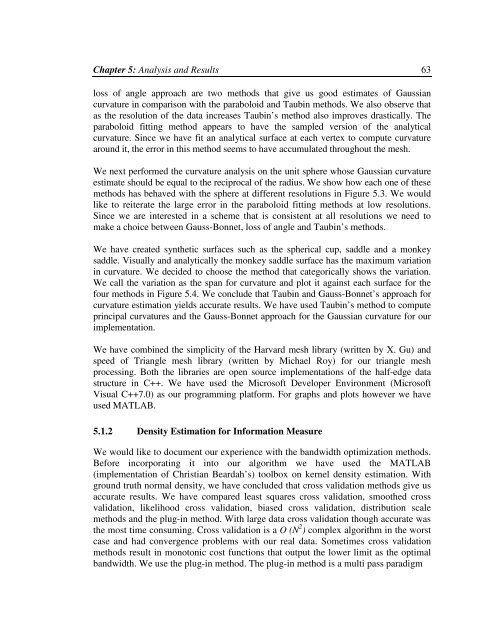To the Graduate Council: I am submitting herewith a thesis written by ...
To the Graduate Council: I am submitting herewith a thesis written by ...
To the Graduate Council: I am submitting herewith a thesis written by ...
You also want an ePaper? Increase the reach of your titles
YUMPU automatically turns print PDFs into web optimized ePapers that Google loves.
Chapter 5: Analysis and Results 63loss of angle approach are two methods that give us good estimates of Gaussiancurvature in comparison with <strong>the</strong> paraboloid and Taubin methods. We also observe thatas <strong>the</strong> resolution of <strong>the</strong> data increases Taubin’s method also improves drastically. Theparaboloid fitting method appears to have <strong>the</strong> s<strong>am</strong>pled version of <strong>the</strong> analyticalcurvature. Since we have fit an analytical surface at each vertex to compute curvaturearound it, <strong>the</strong> error in this method seems to have accumulated throughout <strong>the</strong> mesh.We next performed <strong>the</strong> curvature analysis on <strong>the</strong> unit sphere whose Gaussian curvatureestimate should be equal to <strong>the</strong> reciprocal of <strong>the</strong> radius. We show how each one of <strong>the</strong>semethods has behaved with <strong>the</strong> sphere at different resolutions in Figure 5.3. We wouldlike to reiterate <strong>the</strong> large error in <strong>the</strong> paraboloid fitting methods at low resolutions.Since we are interested in a scheme that is consistent at all resolutions we need tomake a choice between Gauss-Bonnet, loss of angle and Taubin’s methods.We have created syn<strong>the</strong>tic surfaces such as <strong>the</strong> spherical cup, saddle and a monkeysaddle. Visually and analytically <strong>the</strong> monkey saddle surface has <strong>the</strong> maximum variationin curvature. We decided to choose <strong>the</strong> method that categorically shows <strong>the</strong> variation.We call <strong>the</strong> variation as <strong>the</strong> span for curvature and plot it against each surface for <strong>the</strong>four methods in Figure 5.4. We conclude that Taubin and Gauss-Bonnet’s approach forcurvature estimation yields accurate results. We have used Taubin’s method to computeprincipal curvatures and <strong>the</strong> Gauss-Bonnet approach for <strong>the</strong> Gaussian curvature for ourimplementation.We have combined <strong>the</strong> simplicity of <strong>the</strong> Harvard mesh library (<strong>written</strong> <strong>by</strong> X. Gu) andspeed of Triangle mesh library (<strong>written</strong> <strong>by</strong> Michael Roy) for our triangle meshprocessing. Both <strong>the</strong> libraries are open source implementations of <strong>the</strong> half-edge datastructure in C++. We have used <strong>the</strong> Microsoft Developer Environment (MicrosoftVisual C++7.0) as our progr<strong>am</strong>ming platform. For graphs and plots however we haveused MATLAB.5.1.2 Density Estimation for Information MeasureWe would like to document our experience with <strong>the</strong> bandwidth optimization methods.Before incorporating it into our algorithm we have used <strong>the</strong> MATLAB(implementation of Christian Beardah’s) toolbox on kernel density estimation. Withground truth normal density, we have concluded that cross validation methods give usaccurate results. We have compared least squares cross validation, smoo<strong>the</strong>d crossvalidation, likelihood cross validation, biased cross validation, distribution scalemethods and <strong>the</strong> plug-in method. With large data cross validation though accurate was<strong>the</strong> most time consuming. Cross validation is a O (N 2 ) complex algorithm in <strong>the</strong> worstcase and had convergence problems with our real data. Sometimes cross validationmethods result in monotonic cost functions that output <strong>the</strong> lower limit as <strong>the</strong> optimalbandwidth. We use <strong>the</strong> plug-in method. The plug-in method is a multi pass paradigm
















